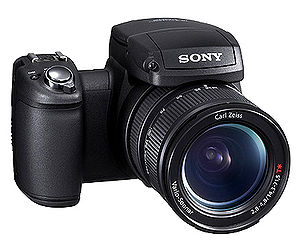- Sony Cyber-shot DSC-R1
-
Sony DSC-R1 
Type Bridge digital camera Sensor 21.5 mm × 14.4 mm CMOS Maximum resolution 3,888 × 2,592 (10 million) Lens Fixed, 14.3–71.5 mm Carl Zeiss Vario-Sonnar T*, 24–120 mm equiv. (5× zoom) Shutter speed range 30–1/2000 s + bulb (3 minutes) Focus areas Multi-point AF (5 area auto select), Centre AF, Spot AF (flexible) Focus modes Single, Monitor, Continuous Continuous shooting 3 frames @ 3.0 frame/s Viewfinder Electronic with diopter adjustment, 235,200 pixel 0.44" TFT LCD ASA/ISO range 160, 200, 400, 800, 1600, 3200 Rear LCD monitor 2.0" top mounted flip and twist Storage Memory Stick (PRO), CompactFlash (CF) (Type I or Type II), Microdrive Weight 995 g or 2.2 lb (including battery) The Sony Cyber-shot DSC-R1 is a bridge digital camera announced by Sony in 2005 (and discontinued in 2006). It featured a 10.3 megapixel APS-C CMOS sensor (21.5 × 14.4 mm), a size typically used in DSLRs and rarely used in bridge cameras (which usually use 2/3" (= 6.6 × 8.8 mm) or 1/1.8" (= 5.3 × 7.1 mm)). This was the first time such a large sensor was incorporated into a bridge camera. Besides the APS-C sensor, R1 also featured a 14.3–71.5 mm Carl Zeiss Vario-Sonnar T* lens, providing for an angle of view equivalent to 24–120 mm on a full frame camera.
Contents
Advantages
Compared to a standard DSLR the Sony R1 has the following advantages:
- since there is no mirror between the sensor and the lens, the lens can be positioned closer to the sensor, which improves the performance at wide angle[citation needed]
- the image in the EVF and LCD screen is bright and the light is amplified. An optical viewfinder instead does not amplify the light, so that it becomes difficult to frame and manually focus when there is not sufficient light.
- technically no dust problems, since the R1 has a fixed lens, though dust can enter the lens itself while zooming
- silent operation, as there is no swinging mirror or physical shutter system
- as there is no shutter system there is essentially no limit to flash sync; photographs can be taken in broad daylight with fill flash at speeds of 1/1,000th of a second or faster
- fewer movable parts, therefore greater reliability[citation needed]
Disadvantages
and the following disadvantages:
- no interchangeable lenses: the supplied lens only covers the 24–120 mm zoom range.
- no optical viewfinder. Furthermore there is some small time shift, i.e. the image appears with a small delay.
- Low frame rate and slow contrast-detection autofocus.[1]
See also
- Sigma DP1
- Micro Four Thirds
- Sigma DP2
References
External links
 Media related to Sony Cyber-shot DSC-R1 at Wikimedia CommonsCategories:
Media related to Sony Cyber-shot DSC-R1 at Wikimedia CommonsCategories:- Cyber-shot cameras
- Bridge digital cameras
Wikimedia Foundation. 2010.
